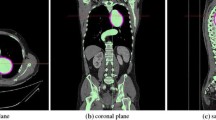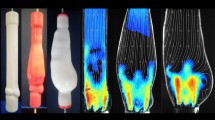Abstract
With a mock circulation, developed at the Aerodynamisches Institut, haemolysis and pressures were measured and the flow patterns near the balloon were made visible. Aortic diameter, length and diameter of the balloon, elasticity modulus of the tube and the pressure to fill and to empty the balloon were varied in the experiments. The pressure measurements indicate that the filling phase can be divided into unsteady and approximately steady parts. Flow visualisation, by means of the hydrogen-bubble technique, shows nearly rectangular velocity profiles. Wall shear stresses, evaluated from these profiles, allow one to determine a critical ratio of balloon to aortic diameter, beyond which damage to the aortic intima due to excessive frictional forces are to be expected. The concentration of plasmahaemoglobin of fresh ACD stabilised pig blood was measured to determine the rate of haemolysis. Scattering can be shown to be less than 10% if the data are properly reduced. One of the major results of this analysis is that the rate of haemolysis increases linearly with the magnitude of the balloon surface.
Sommaire
Avec une circulation simulée, mise au point dans l'Aerodynamisches Institut, l'hémolyse et les pressions ont été mesurées, et le mode de circulation près du ballon ont été rendus visibles. Au cours des expériences, on a fait varier le diamètre de l'aorte, la longueur et le diamètre du ballon, le module d'élasticité du tube, et la pression nécessaire pour remplir et vider le ballon. Les mesures de pression indiquent que la phase de remplissage peut se subdiviser en une partie stable et une partie quasi-stable. La visualisation de la circulation, à l'aide de la technique à bulles d'hydrogène, indique des profils de vitesse presque rectangulaires. Les efforts tranchants sur la paroi, évalués à partir de ces profils, permettent de déterminer un rapport critique entre la diamètre du ballon et le diamètre de l'aorte, au-delà duquel on peut s'attendre à des dégâts de l'intima aortique dus à des forces de friction trop élevées. La concentration de plasma-hémoglobine dans le sang de porc MCA récemment stabilisé a été mesuré en vue de déterminer le taux d'hémolyse. Si les données sont correctement réduites, on peut démontrer que la dispersion est inférieure à 10%. Un des principaux résultats de cette analyse est le fait que le taux d'hémolyse s'accroît linéairement avec la superficie du ballon.
Zusammenfassung
In einem Modellouaislaut, entwickelt im aerodynamische Institut, wurden Hämolyse und Drücke gemessen und Strömungsbilder in der Nähe des Ballons sichtbar gemacht. Durchmesser der Aorta, Länge und Durchmesser des Ballons, Elastizltätsmodul des Gefäßes un dder Druck zum Füllen und Entleeren des Ballons werden in den Experimenten variiert. Die Druckmessungen ergeben, daß die Füllphase in einen unstetigen und einen nahezu stetigen Teil gegliedert werden kann. Die Sichtbarmachung des Stroms—mit Hilfe der Wasserstoffblasenmethode—zeigt nahezu rechteckige Geschwindigkeitsprofile. Wandscherspannungen, die aus diesen Profilen errechnet werden, gestatten eine Bestimmung des kritischen Verhältnisses zwischen Schub und Aorta-Durchmesser, über dem man mit einer Beschädigung der aortischen Intima wegen zu großer Spannungen rechnen muß Due Konzentration von Plasmahämoglobin von frischen ACD-stabilisiertem Schweineblut wurde gemessen, um die Geschwindigkeit der Hämolyse zu bestimmen. Streuung kann weniger als 10% betragen, wenn die Daten richtig reduziert werden. Eines der wichtigsten Resultate dieser Analyse besteht darin, daß die Homolysevate linearer mit der Große der Oberfläche des Ballons ansteigt.
Similar content being viewed by others
References
Bleifeld, W., Bussmann, W. D., Meyer, J. Irnich, W. andEffert, S. (1970) Der Einfluß der intraaortalen Ballonpulsation auf Hämodynamik und Koronardurchblutung im experimentellen kardiogenen Schock. Sonderdruck aus: Verhandlungen der Deutschen Gesellschaft für Kreislaufforschung,36.
Gellert, J., Leodolter, S., Deutsch, M., Enekel, W., Fasching, W., Lechner, K., Wolner, E., Navratil, J. andDeutsch, E. (1972) Tierexperimentelle Untersuchungen über Einfluß einer mechanischen Kreislaufunterstützung mit der intraaortalen Ballonpumpe auf das Gerinnungssystem.Thoraxchirurgie 20, 219–228.
Leinbach, R. C., Dinsmore, R. W., Mendth, E. D., Buchley, M. J., Dunkman, W. B., Austen, W. G. andSanders, C. A. (1972) Selective coronary and left ventricular cineangiography during intraaortic balloon pumping for cardiogenic shock.Circulation,45, 845–852.
Watson, J. T., Willerson J. T., Fixler, D. E., Browning, R. M. andSugg, W. L. (1972) Changes in collateral coronary blood flow (CCBF) distal to a coronary occlusion during intra-aortic balloon pumping (IABP).Trans. Amer. Soc. Artif. Int. Organs 19, 402–407.
Geller, E. W. (1955) An electrochemical method of visualizing the boundary layer.J. Aero. Sci. 22, 869.
Caro, C. G. andFitzgerald, J. M. (1971) Atheroma and arterial wall shear observation, correlation and proposal of a shear dependent mass transfer mechanism for atherogenesis.Proc. Roy. Soc. B, 177, 109–159.
Bregman, D. andGoetz, R. H. (1972) A new concept in circulatory assistance: The dual-chambered intraortic balloon.Mount Sinai J. Med. 39.
Richterich, R. (1971)Klinische Chemie. Verlag S. Karger, Basel, München, 387.
Leinbach, R. C., Nyilas, E., Caulfield, J. B., Buckley, M. J. andAusten, W. G. (1972) Evaluation of hematologic effects of intra-aortic balloon assistance in man.Trans. Amer. Soc. Artif. Int. Organs,18, 493–500.
Bernstein, E. F., Blackshear, P. L. andKeller, K. H. (1967) Factors influencing erythrocyte destruction in artificial organs.Amer. J. Surg. 114, 126–138.
Author information
Authors and Affiliations
Rights and permissions
About this article
Cite this article
Heuser, G. Flow observation and model experiments on blood damage in the area of the balloon used for intra-aortic balloon pumping. Med. Biol. Eng. Comput. 15, 254–263 (1977). https://doi.org/10.1007/BF02441046
Received:
Accepted:
Issue Date:
DOI: https://doi.org/10.1007/BF02441046




